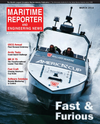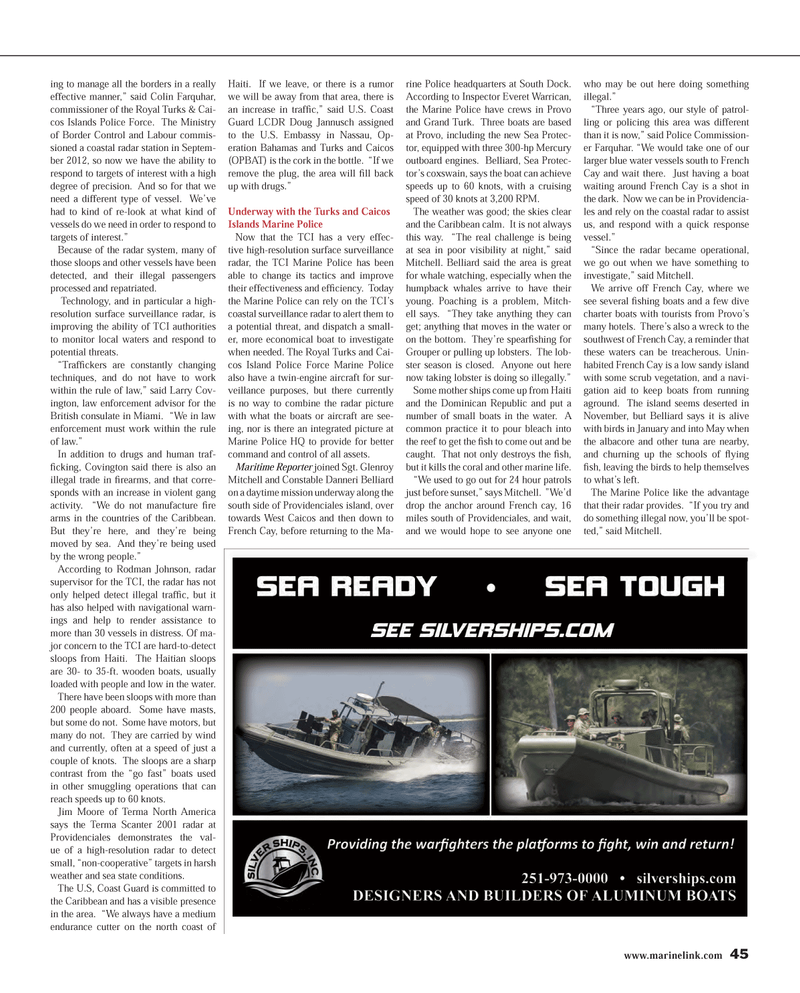
Page 45: of Maritime Reporter Magazine (March 2014)
U.S. Coast Guard Annual
Read this page in Pdf, Flash or Html5 edition of March 2014 Maritime Reporter Magazine
www.marinelink.com 45 ing to manage all the borders in a really effective manner,” said Colin Farquhar, commissioner of the Royal Turks & Cai- cos Islands Police Force. The Ministry of Border Control and Labour commis- sioned a coastal radar station in Septem- ber 2012, so now we have the ability to respond to targets of interest with a high degree of precision. And so for that we need a different type of vessel. We’ve had to kind of re-look at what kind of vessels do we need in order to respond to targets of interest.”
Because of the radar system, many of those sloops and other vessels have been detected, and their illegal passengers processed and repatriated. Technology, and in particular a high- resolution surface surveillance radar, is improving the ability of TCI authorities to monitor local waters and respond to potential threats. “Traffi ckers are constantly changing techniques, and do not have to work within the rule of law,” said Larry Cov- ington, law enforcement advisor for the
British consulate in Miami. “We in law enforcement must work within the rule of law.”
In addition to drugs and human traf- fi cking, Covington said there is also an illegal trade in fi rearms, and that corre- sponds with an increase in violent gang activity. “We do not manufacture fi re arms in the countries of the Caribbean.
But they’re here, and they’re being moved by sea. And they’re being used by the wrong people.”
According to Rodman Johnson, radar supervisor for the TCI, the radar has not only helped detect illegal traffi c, but it has also helped with navigational warn- ings and help to render assistance to more than 30 vessels in distress. Of ma- jor concern to the TCI are hard-to-detect sloops from Haiti. The Haitian sloops are 30- to 35-ft. wooden boats, usually loaded with people and low in the water.
There have been sloops with more than 200 people aboard. Some have masts, but some do not. Some have motors, but many do not. They are carried by wind and currently, often at a speed of just a couple of knots. The sloops are a sharp contrast from the “go fast” boats used in other smuggling operations that can reach speeds up to 60 knots.
Jim Moore of Terma North America says the Terma Scanter 2001 radar at
Providenciales demonstrates the val- ue of a high-resolution radar to detect small, “non-cooperative” targets in harsh weather and sea state conditions.
The U.S, Coast Guard is committed to the Caribbean and has a visible presence in the area. “We always have a medium endurance cutter on the north coast of
Haiti. If we leave, or there is a rumor we will be away from that area, there is an increase in traffi c,” said U.S. Coast
Guard LCDR Doug Jannusch assigned to the U.S. Embassy in Nassau, Op- eration Bahamas and Turks and Caicos (OPBAT) is the cork in the bottle. “If we remove the plug, the area will fi ll back up with drugs.”
Underway with the Turks and Caicos
Islands Marine Police
Now that the TCI has a very effec- tive high-resolution surface surveillance radar, the TCI Marine Police has been able to change its tactics and improve their effectiveness and effi ciency. Today the Marine Police can rely on the TCI’s coastal surveillance radar to alert them to a potential threat, and dispatch a small- er, more economical boat to investigate when needed. The Royal Turks and Cai- cos Island Police Force Marine Police also have a twin-engine aircraft for sur- veillance purposes, but there currently is no way to combine the radar picture with what the boats or aircraft are see- ing, nor is there an integrated picture at
Marine Police HQ to provide for better command and control of all assets.
Maritime Reporter joined Sgt. Glenroy
Mitchell and Constable Danneri Belliard on a daytime mission underway along the south side of Providenciales island, over towards West Caicos and then down to
French Cay, before returning to the Ma- rine Police headquarters at South Dock.
According to Inspector Everet Warrican, the Marine Police have crews in Provo and Grand Turk. Three boats are based at Provo, including the new Sea Protec- tor, equipped with three 300-hp Mercury outboard engines. Belliard, Sea Protec- tor’s coxswain, says the boat can achieve speeds up to 60 knots, with a cruising speed of 30 knots at 3,200 RPM.
The weather was good; the skies clear and the Caribbean calm. It is not always this way. “The real challenge is being at sea in poor visibility at night,” said
Mitchell. Belliard said the area is great for whale watching, especially when the humpback whales arrive to have their young. Poaching is a problem, Mitch- ell says. “They take anything they can get; anything that moves in the water or on the bottom. They’re spearfi shing for
Grouper or pulling up lobsters. The lob- ster season is closed. Anyone out here now taking lobster is doing so illegally.”
Some mother ships come up from Haiti and the Dominican Republic and put a number of small boats in the water. A common practice it to pour bleach into the reef to get the fi sh to come out and be caught. That not only destroys the fi sh, but it kills the coral and other marine life. “We used to go out for 24 hour patrols just before sunset,” says Mitchell. ”We’d drop the anchor around French cay, 16 miles south of Providenciales, and wait, and we would hope to see anyone one who may be out here doing something illegal.” “Three years ago, our style of patrol- ling or policing this area was different than it is now,” said Police Commission- er Farquhar. “We would take one of our larger blue water vessels south to French
Cay and wait there. Just having a boat waiting around French Cay is a shot in the dark. Now we can be in Providencia- les and rely on the coastal radar to assist us, and respond with a quick response vessel.” “Since the radar became operational, we go out when we have something to investigate,” said Mitchell.
We arrive off French Cay, where we see several fi shing boats and a few dive charter boats with tourists from Provo’s many hotels. There’s also a wreck to the southwest of French Cay, a reminder that these waters can be treacherous. Unin- habited French Cay is a low sandy island with some scrub vegetation, and a navi- gation aid to keep boats from running aground. The island seems deserted in
November, but Belliard says it is alive with birds in January and into May when the albacore and other tuna are nearby, and churning up the schools of fl ying fi sh, leaving the birds to help themselves to what’s left.
The Marine Police like the advantage that their radar provides. “If you try and do something illegal now, you’ll be spot- ted,” said Mitchell.
MR #3 (42-49).indd 45 3/5/2014 10:05:01 AM

 44
44

 46
46
